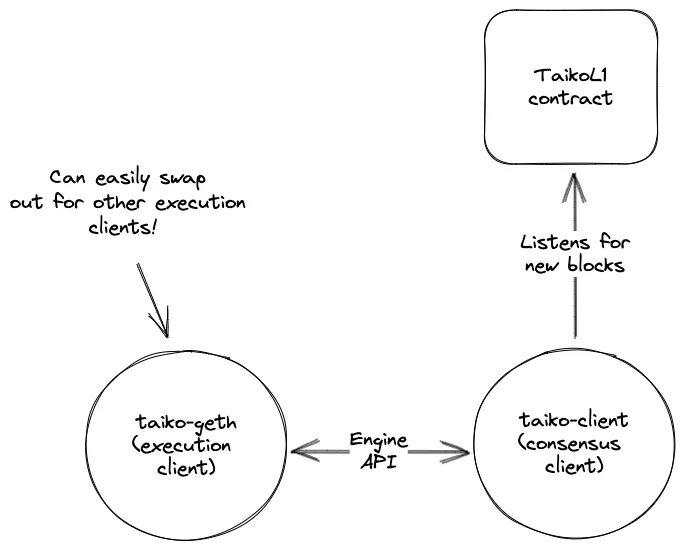Taiko nodes
Taiko nodes are minimally modified Ethereum execution clients that consist of two parts:
You can think of it like an Ethereum mainnet node, except replacing the consensus client with taiko-client. taiko-client then drives taiko-geth over the Engine API. This is a modular design that allows easily plugging in other execution clients.

taiko-geth
The taiko-geth software is a fork of go-ethereum with some changes made according to the Taiko protocol.
Like Ethereum mainnet execution engines, taiko-geth listens to new L2 transactions broadcasted in the L2 network, executes them in the EVM, and holds the latest state and database of all current L2 data.
You can see all the changes made in the taiko-geth fork at geth.taiko.xyz!
taiko-client
The taiko-client software replaces the consensus client piece of an Ethereum mainnet node. It connects to taiko-geth, and the compiled binary includes three sub-commands:
driver
The driver serves as an L2 consensus client. It listens for new L2 blocks from the TaikoL1 protocol contract, then directs the connected L2 execution engine to insert them or reorganize its local chain through the Engine API.
proposer
The proposer fetches pending transactions from the L2 execution engine’s mempool, then tries to propose them to the TaikoL1 protocol contract.
prover
The prover requests validity proofs from the ZK-EVM and sends transactions to prove the proposed blocks are valid or invalid.
Chain synchronization process
The Taiko protocol allows a block’s timestamp to be equal to its parent
block’s timestamp, which differs from the original Ethereum protocol. So it’s
fine that there are two TaikoL1.proposeBlock transactions included in one L1
block.
Taiko client’s driver informs the L2 execution engine about Taiko protocol contract’s latest verified L2 head and tries to let it catch up with the latest verified L2 block through P2P at first.
The driver monitors the execution engine’s sync progress: If it’s unable to make any new sync progress in a period of time, the driver switches to inserting the verified blocks into its local chain through the Engine API one by one.
After the L2 execution engine catches up with the latest verified L2 head, the driver subscribes to TaikoL1.BlockProposed events. When a new pending block is proposed, the driver:
- Gets the corresponding
TaikoL1.proposeBlockL1 transaction. - Decompresses the
txListBytesfrom the transaction’s calldata (and blobdata if enabled). - Decodes the
txListand block metadata from the decompressed bytes. - Checks whether the
txListis valid based on the rules defined in the Taiko protocol.
If the txList is valid, the driver:
- Assembles a deterministic
TaikoL2.anchortransaction based on the rules defined in the protocol and puts it as the first transaction in the proposedtxList. - Uses this
txListand the decoded block metadata to assemble a deterministic L2 block. - Directs the L2 execution engine to insert this assembled block and sets it as the current canonical chain’s head via the Engine API.
If the txList is invalid, the driver:
- Assembles an empty L2 block with only the anchor transaction.
Process of proposing a block
To propose a block, the proposer:
- Fetches the pending transactions from the L2 execution engine through the
txpool_contentRPC method. - If there are too many pending transactions in the L2 execution engine, splits them into several smaller
txLists. This is because the Taiko protocol restricts the max size of each proposedtxList. - Proposes all split
txListsby sendingTaikoL1.proposeBlocktransactions.
Process of proving a block
When a new block is proposed, the prover:
- Gets the
TaikoL1.proposeBlockL1 transaction calldata, decodes it, and validates thetxList, just like what thedriversoftware does. - Waits until the corresponding block is inserted by the L2 execution engine’s
driversoftware. - Generates a validity proof for that block asynchronously.
If the proposed block has a valid or invalid txList, the prover:
- Generates a Merkle proof of the block’s
TaikoL2.anchortransaction to prove its existence in theblock.txRoot’s MPT and this transaction receipt’s Merkle proof in theblock.receiptRoot’s MPT from the L2 execution engine. - Submits the
TaikoL2.anchortransaction’s RLP encoded bytes, its receipt’s RLP encoded bytes, the generated Merkle proofs, and a validity proof to prove this block valid by sending aTaikoL1.proveBlocktransaction (the block is valid even for an invalidtxListbecause we prove the invalidtxListmaps to an empty block with only the anchor transaction).
Taiko Node API
Using a Taiko node should feel the same as using any other L1 node, because we essentially re-use the L1 client and make a few backwards-compatible modifications.
Differences from a Geth client
View the fork diff page to see the minimal set of changes made to Geth here.
Execution JSON-RPC API
Check out the execution client spec here.
Engine API
Check out the engine API spec here.
Hive test harness
If a Taiko node should feel the same as using any other L1 node, it should surely be able to pass the hive e2e test harness. At the time of writing, the hive tests are actually one of the best references for what the API of an Ethereum node actually is.